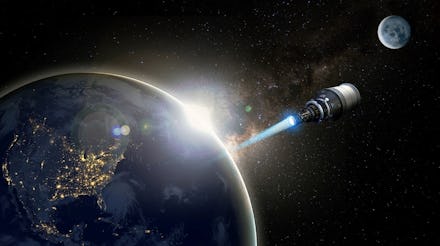The United States military wants to nuke space, but not for the reason that you're thinking (well, not yet at least). This week, the Defense Advanced Research Projects Agency (DARPA) announced that it was giving out three contracts to companies who will work to design a spacecraft that will use nuclear thermal propulsion (NTP) technology to blast off into the stratosphere. The goal is to take this craft from theoretical to orbiting the Earth by 2025.
The three companies that will be involved are the usual suspects in the space race: aerospace and military contractor extraordinaire Lockheed Martin, Predator drone creator General Atomics, and Blue Origin, which is somehow even more devious and malevolent than the others simply because it is owned by Lex Luthor-lookalike Jeff Bezos. The firms will be participating in what DARPA calls its Demonstration Rocket for Agile Cislunar Operations (DRACO) program, which seeks to make nuclear thermal propulsion a reality.
General Atomics will be designing the nuclear reactor. The company will have 18 months to do so, and has netted a $22.2 million contract in order to pursue the project, according to CNBC. Meanwhile, Lockheed Martin and Blue Origin will be taking on the actual spacecraft design. They raked in $2.9 million and $2.5 million, respectively.
So why exactly is the U.S. military so set on using nuclear power to push its rockets into space? It's largely about the ability to move smoother and faster in the space between Earth and the moon. Currently, spacecraft rely on either electric or chemical propulsion systems, which significantly limit the ability of aircraft to maneuver once they exit the Earth's atmosphere. Electric systems have low thrust-to-weight ratios, which means that they accelerate slowly, while chemical systems have poor propellant efficiency, meaning they require a lot of energy to create the necessary thrust.
A nuclear-powered system would, in theory, solve these issues, by providing a high thrust-to-weight ratio that would offer more acceleration and having a high propellant efficiency that would allow the spacecraft to move faster across long distances without requiring lots of energy. It does this by transferring heat from a reactor to a liquid propellant; the heat converts the liquid into a gas, which expands through a nozzle to provide enough thrust to propel the ship onward. If you're thinking the nuclear power might be better for the planet, unfortunately you're probably not going to see much of an improvement given the rockets that take these crafts to orbit still rely on petroleum-based rocket fuel to get into space. Plus, the thrust will happen outside of the atmosphere anyway.
This development would be essential for future ambitious space travel, including exploring distant planets. "Nuclear thermal propulsion is a transformative technology that will dramatically change the way spacecraft will operate, increasing agility and allowing more efficient travel to Mars and beyond in far less time than conventional propulsion systems," Bill Pratt, Lockheed Martin Space’s manager of Human Exploration Advanced Programs, told CNBC.
NASA has similarly explored the concept of nuclear propulsion. The agency considers it one of the potential keys for manned space travel to Mars as it would shorten the time it would take to get from our planet to the red rock off in the distance and could offer flexibility for the mission that may run into unforeseen challenges while traversing space. If we have to put nuclear technology into space, it's better this than Elon Musk's proposal that we nuke Mars.
